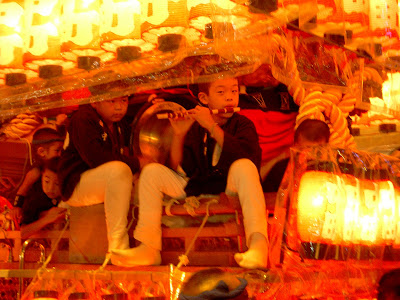 The Kishiwada Danjiri Matsuri, allegedly one of the deadliest festival in the world. Although official statistics seem quite hard to come by, judging from the hearsay on the ground and the rather large presence of Prefecture Police, the 4-ton danjiri claim several lives each year. Although I didn't witness any deaths, I did see a constant stream of ambulances speeding into the festival area to combat broken legs, sprained ankles, and a few concussions...
The Kishiwada Danjiri Matsuri, allegedly one of the deadliest festival in the world. Although official statistics seem quite hard to come by, judging from the hearsay on the ground and the rather large presence of Prefecture Police, the 4-ton danjiri claim several lives each year. Although I didn't witness any deaths, I did see a constant stream of ambulances speeding into the festival area to combat broken legs, sprained ankles, and a few concussions...The festival is held on the first full moon of autumn, and is a Shinto procession in Kishiwada, a suburban city in the Osaka Prefecture, to pray for a fruitful harvest. According to the festival's page, it dates back to 1703, when the Lord of Kishiwada Castle, held the first "Inari Matsuri."
The Danjiri Matsuri is comprised of 33 danjiri, massive wheeled wooden shrines with amazingly intricate and beautiful carvings of gods, demons, samurai, and animals. These floats are pushed and pulled for two days and nights throughout the streets of Kishiwada by guilds of several hundred members, chanting and singing throughout the city.
On the top of the danjiri is the daiku-gata, the carpenters who hold a special place of honor in the guilds. It is the daiku-gata's duty to guide the kumi in pulling and directing the steering of the mae-teko (front rudder) and the ushiro-teko (rear rudder). As the danjiri pick up speed through the narrow streets and make hairpin turns, the daiku-gata goes into convulsions of dance, jumping from side to side of the danjiri and frantically waving his red fans - doing everything possible to ensure that the float doesn't tip over.
The Danjiri Matsuri was filled with games, gambling, great beer, and amazing food. I tried so many things that I never new existed before. When you go to a Japanese restaurants, the normal things you find are sushi, teriyaki, and tempura. There is a whole world of Osaka festival and bar food - simply delcious. Starting with yakitori and kushikatsu, which are some of the more common bar foods - the kushikatsu was amazing. Take any kind of meat, fish, vegetable, or great combos (octopous and cheese!), put it on a stick, dip it in bread crumbs, fry for a few minutes, stupendous! Or the amazing complexities of okonomiyaki and takoyaki. Okonomiyaki consisted of a thin pancake stacked with cabbage, scallions, some bacon, a lot of ginger, a fried egg, and all covered in Worcestershire sauce and mayonnaise. It has everything you need for a hard night out. And as for takoyaki, well who knew octopus balls could be so tasty....
A danjiri going down the street
For my first night in a new country, this festival was simply amazing. Not only was it so different than anything else that I had ever experienced, but I was struck by some of my preconceptions regarding Japan. The thought of wheeling huge carts through human power through tiny streets and around extreme turns was so counter intuitive to my earlier thoughts. Yet for all of the danger, there was an amazing camaraderie throughout the festival. People came together to welcome me, whether through sharing of food and drink, a dance, a few words, or a simple smile. And that will be what I remember most of the Danjiri Matsuri.













